Glorious Coco's Palm Trees (Bee Burgers)
Hey everyone, if you were a little honey bee, this is what a proverbial Mcdonald's burder would look like. The bees really love foraging these blossoms. These trees are very tall the only way I could get a decent picture was to zoom in with my cell cam!
Below a glorious ground shot of this incredibly majestic tree an amazing blue sky background!
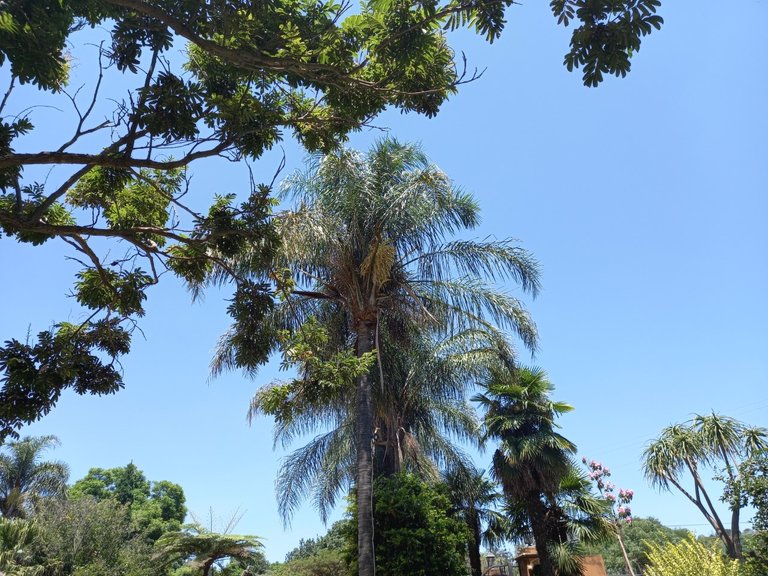
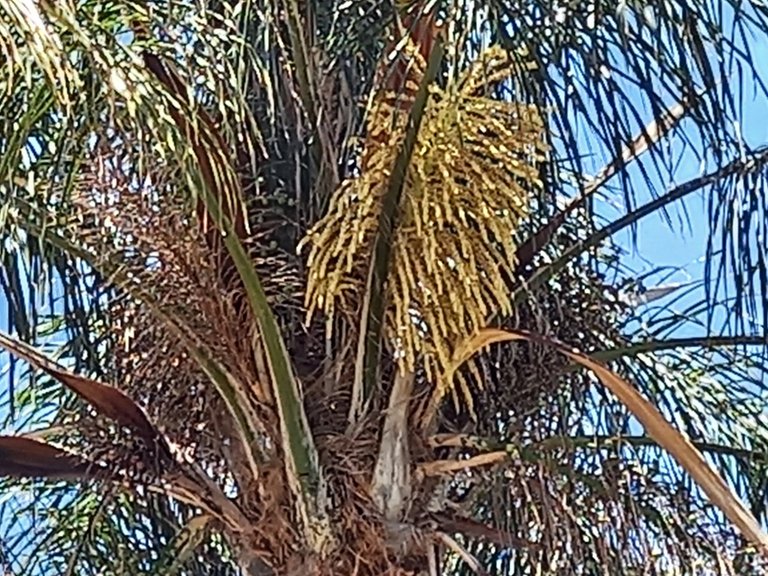
If you look really close you will notice tons of little black foraging honey bees!
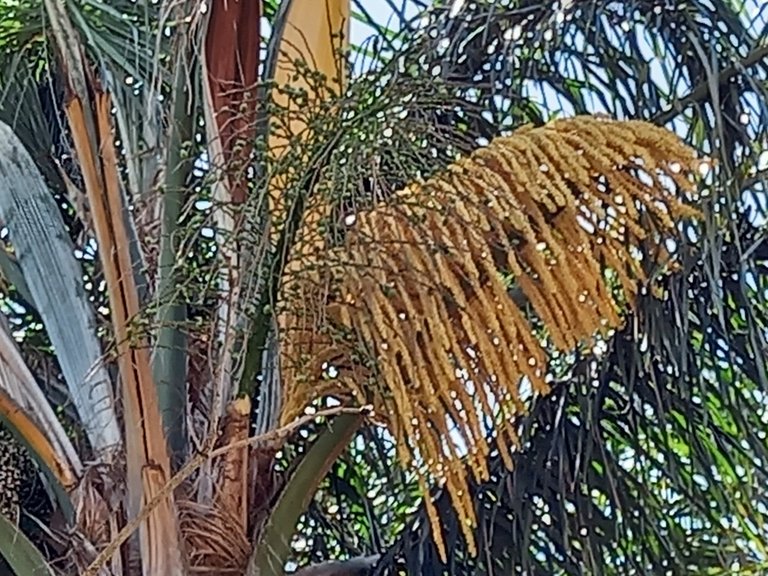
Syagrus romanzoffiana
From Wikipedia, the free encyclopedia
Jump to navigation
Jump to search
Queen palm
Starr 020617-0019 Syagrus romanzoffiana.jpg
Scientific classification edit
Kingdom: Plantae
Clade: Tracheophytes
Clade: Angiosperms
Clade: Monocots
Clade: Commelinids
Order: Arecales
Family: Arecaceae
Genus: Syagrus
Species: S. romanzoffiana
Binomial name
Syagrus romanzoffiana
(Cham.) Glassman [1968][1]
Synonyms[5][6]
Cocos romanzoffiana Cham. [1822]
Calappa romanzoffiana (Cham.) Kuntze [1891]
Arecastrum romanzoffianum (Cham.) Becc. [1916]
Arecastrum romanzoffianum var. australe (Mart.) Becc. [1916]
Arecastrum romanzoffianum var. ensifolium (Drude) Becc. [1916]
Arecastrum romanzoffianum var. genuinum Becc. [1916]
Arecastrum romanzoffianum var. genuinum subvar. minus Becc. [1916]
Arecastrum romanzoffianum var. micropindo Becc. [1916]
Cocos australis Mart. [1844]
Cocos plumosa Hook.f. [1860]
Cocos datil Drude & Griseb. [1879]
Cocos geriba Barb.Rodr. [1879]
Cocos acrocomioides Drude [1881]
Cocos botryophora Mart. var. ensifolia Drude [1881]
Cocos martiana Drude & Glaz [1881]
Calappa acrocomioides (Drude) Kuntze [1891]
Calappa australis (Mart.) Kuntze [1891]
Calappa datil (Drude & Griseb.) Kuntze [1891]
Calappa martiana (Drude & Glaz.) Kuntze [1891]
Calappa plumosa (Hook.f.) Kuntze [1891]
Cocos sapida Barb.Rodr. [1899][2][3][4]
Cocos arechavaletana Barb.Rodr. [1901]
Cocos romanzoffiana var. plumosa (Hook.f.) A.Berger [1912]
Syagrus sapida (Barb.Rodr.) Becc. [1916][3]
Syagrus romanzoffiana, the queen palm[7] or cocos palm, is a palm native to South America, introduced throughout the world as a popular ornamental garden tree. S. romanzoffiana is a medium-sized palm, quickly reaching maturity at a height of up to 15 m (49 ft) tall, with pinnate leaves having as many as 494 pinnae (leaflets), although more typically around 300, each pinna being around 50 centimetres (18 in) in length and 3–5 centimetres (1–2 in) in width.
Contents
1 Etymology
2 Taxonomy
3 Distribution
3.1 Non-native distribution
4 Ecology
5 Cultivation and uses
6 Gallery
7 References
8 External links
Etymology
Named after Nikolay Rumyantsev (1754–1826), who was Russia's Foreign Minister and Imperial Chancellor and notable patron of the Russian voyages of exploration. He sponsored the first Russian circumnavigation of the globe.
As a result of the nomenclature confusion, they often retain a previous name in popular usage.
Taxonomy
A 'Cocos plumosos' palm tree growing in a lawn in front of a residence in Los Angeles in 1920.
This palm was first scientifically described and validly published as Cocos romanzoffiana in 1822 in Paris in a folio of illustrations made by the artist Louis Choris, with a description by the French-German poet and botanist Adelbert von Chamisso.[8] Both men had participated in the first Russian scientific expedition around the world under command of Otto von Kotzebue, and funded by Nikolay Rumyantsev, during which they collected this plant in the hinterland of Santa Catarina, Brazil in late 1815.
Meanwhile, in England, sometime around 1825 Loddiges nursery had imported seed of a palm from Brazil which they dubbed Cocos plumosa in their catalogue, a nomen nudum. The horticulturist John Claudius Loudon in 1830 listed this plant among 3 species of the Cocos genus then grown in Britain, and mentioned its possible identification as Karl von Martius' C. comosa.[9] One of Loddiges' seedlings had eventually found its way to the new palm stove built at Kew Gardens in the 1840s, where it had grown to a height of 50–60 ft, and where botanists had been determined it to be another of von Martius' species; C. coronata. In 1859 this palm flowered and produced fruit for the first time, which made it clear that its previous identification was incorrect and thus the director of the garden, Joseph Dalton Hooker, 'reluctantly' published a valid description for Loddiges' name C. plumosa in 1860.[10] C. plumosa became a popular ornamental plant around the world, and plants continued to be sold under this name as of 2000.[11]
From 1887 onwards Odoardo Beccari published a review of the genus Cocos. Under subgenus Arecastrum he listed the taxa C. romanzoffiana of Santa Catarina, C. plumosa known only from cultivation from seedlings from the plant in Kew, C. australis of Argentina to Paraguay, C. datil of eastern Argentina and Uruguay, C. acrocomioides of Mato Grosso do Sul, C. acaulis of Piauí, Goiás and recently collected from the mountains of Paraguay bordering Brazil, and C. geriba (syn. C. martiana) known as a variable species cultivated in gardens throughout Brazil (Rio Grande do Sul, Minas Gerais, Paraná, Rio de Janeiro) and the Mediterranean region. Beccari noted that many of the palms being offered in the catalogues under various species names were actually C. geriba.[12]
In 1912 Alwin Berger reduced the taxon C. plumosa, hitherto still only known from thousands in cultivation around the world yet not known from the wild, to a variety of C. romanzoffiana, as C. romanzoffiana var. plumosa.[13]
It was first moved from the genus Cocos in 1891 by Otto Kuntze in his Revisio Generum Plantarum, which was widely ignored, but in 1916 Beccari raised Arecastrum to a monotypic genus and synonymised all species in the former subgenus to A. romanzoffianum. By this time South American imports of palm seed were being sold across Europe under a plethora of names, according to Beccari often mislabelled but impossible to determine down to 'correct' geographical species, thus he interpreted the taxa to belong to a single extremely variable species. This interpretation was long followed. Beccari also considered C. botryophora part of this species, an interpretation that is now partially rejected. Beccari recognised the following, now rejected, varieties:[ More here as per wikipedia.org https://en.wikipedia.org/wiki/Syagrus_romanzoffiana
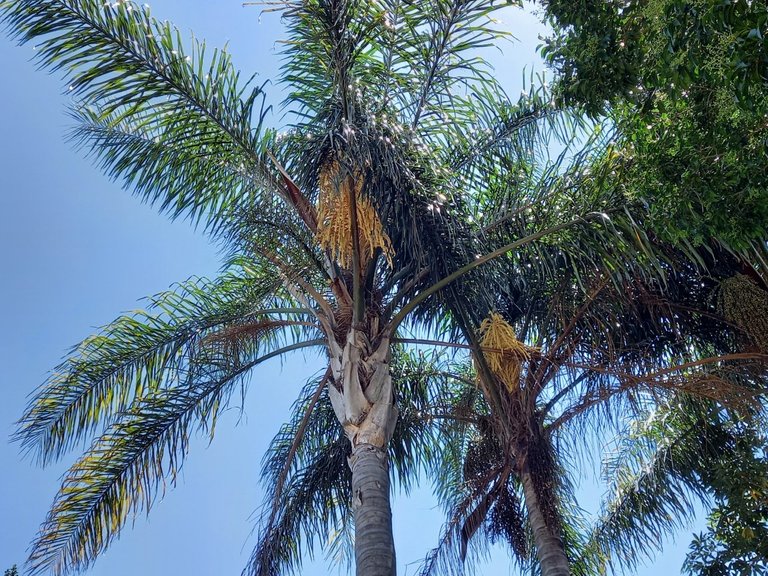
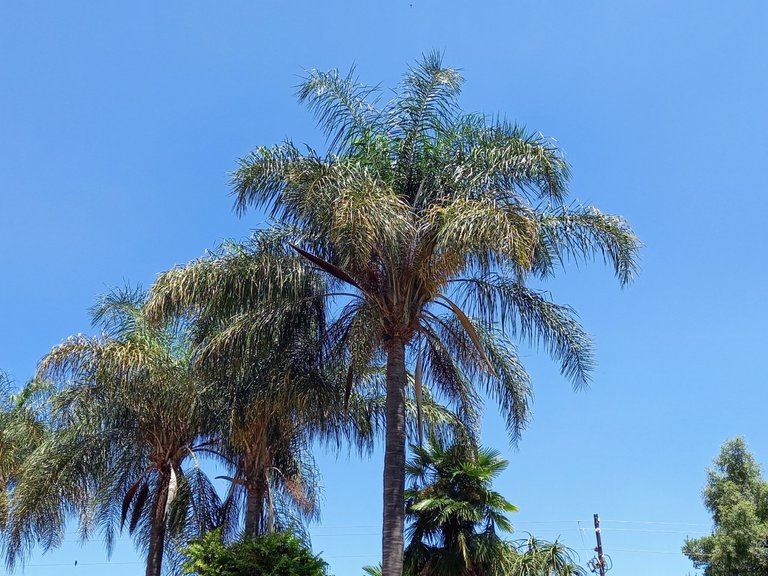
Nature the incredible!
May you have the most incredible Friday! Love and light, be blessed!
Cheer$:)
Beautiful tree, but I don't like them in my garden as they are quite a bit of work to keep good looking, and they mess quite a bit too!!
True that brothehr especially if you have a pool, loooong time are you well??